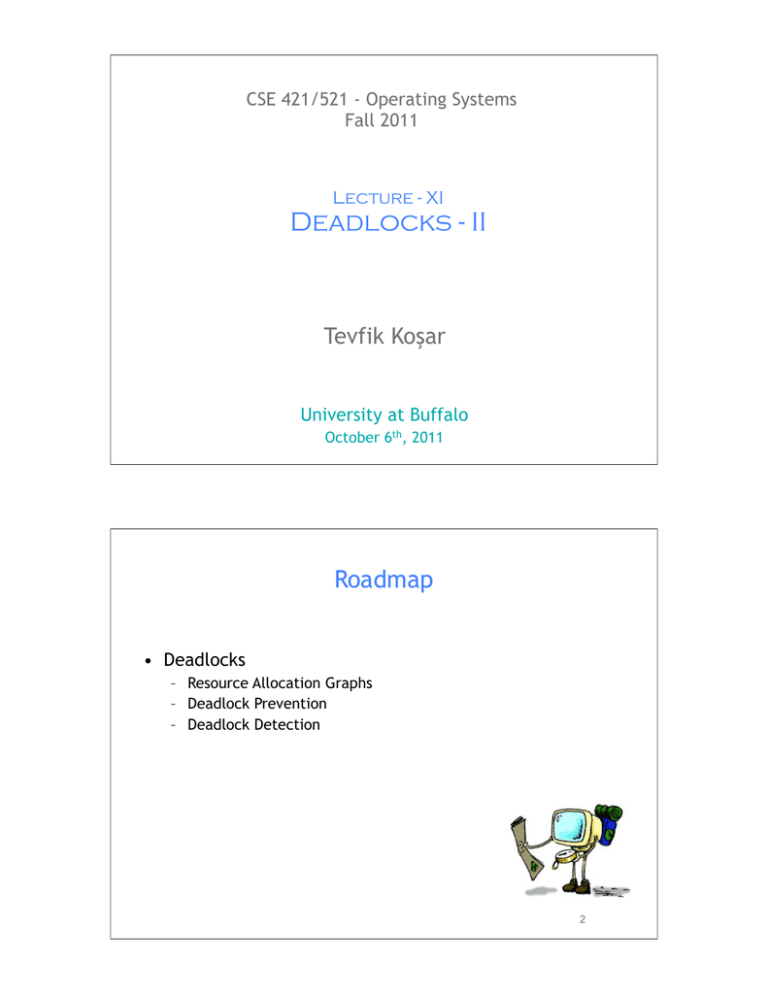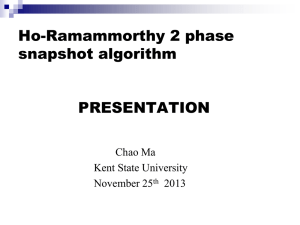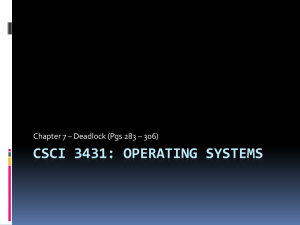Deadlocks - II Roadmap Tevfik Koşar CSE 421/521 - Operating Systems
advertisement

CSE 421/521 - Operating Systems
Fall 2011
Lecture - XI
Deadlocks - II
Tevfik Koşar
University at Buffalo
October 6th, 2011
1
Roadmap
• Deadlocks
– Resource Allocation Graphs
– Deadlock Prevention
– Deadlock Detection
2
Deadlock Characterization
Deadlock can arise if four conditions hold simultaneously.
1. Mutual exclusion: nonshared resources;
only one process at a time can use a specific
resource
2. Hold and wait: a process holding at least
one resource is waiting to acquire additional
resources held by other processes
3. No preemption: a resource can be released
only voluntarily by the process holding it,
after that process has completed its task
3
Deadlock Characterization (cont.)
Deadlock can arise if four conditions hold simultaneously.
4. Circular wait: there exists a set {P0, P1, …,
Pn} of waiting processes such that P0 is
waiting for a resource that is held by P1, P1
is waiting for a resource that is held by
P2, …, Pn–1 is waiting for a resource that is
held by
Pn, and Pn is waiting for a resource that is
held by P0.
4
Resource-Allocation Graph
• Used
to describe deadlocks
• Consists of a set of vertices V and a set of edges E.
• V is partitioned into two types:
– P = {P1, P2, …, Pn}, the set consisting of all the processes
in the system.
– R = {R1, R2, …, Rm}, the set consisting of all resource
types in the system.
• P requests R – directed edge P1 → Rj
• R is assigned to P – directed edge Rj → Pi
5
Resource-Allocation Graph (Cont.)
• Process
• Resource Type with 4 instances
Pi
• Pi requests instance of Rj
• Pi is holding an instance of Rj
Rj
Pi
Rj
6
Example of a Resource Allocation Graph
7
Basic Facts
• If graph contains no cycles ⇒ no deadlock.
• If graph contains a cycle ⇒ there may be a
deadlock
– if only one instance per resource type, then deadlock.
– if several instances per resource type, possibility of
deadlock.
8
Resource Allocation Graph – Example 1
! No Cycle, no Deadlock
9
Resource Allocation Graph – Example 2
! Cycle, but no Deadlock
10
Resource Allocation Graph – example 3
! Deadlock
Which Processes
deadlocked?
! P1 & P2 & P3
11
Exercise
(Silberschatz pp.249-251)
to
12
13
Rule of Thumb
• A cycle in the resource allocation graph
– Is a necessary condition for a deadlock
– But not a sufficient condition
14
Methods for Handling Deadlocks
• Ensure that the system will never enter a
deadlock state.
!deadlock prevention or avoidance
• Allow the system to enter a deadlock state and
then recover.
!deadlock detection
• Ignore the problem and pretend that deadlocks
never occur in the system
! Programmers should handle deadlocks (UNIX, Windows)
15
Deadlock Prevention
! Ensure
one of the deadlock conditions cannot hold
!Restrain the ways request can be made.
• Mutual Exclusion – not required for sharable resources; must hold
for nonsharable resources.
–
Eg. read-only files
• Hold and Wait – must guarantee that whenever a process requests
a resource, it does not hold any other resources.
1. Require process to request and be allocated all its resources before it
begins execution
2. or allow process to request resources only when the process has
none.
Example: Read from DVD to memory, then print.
1. holds printer unnecessarily for the entire execution
• Low resource utilization
2. may never get the printer later
• starvation possible
16
Deadlock Prevention (Cont.)
• No Preemption –
– If a process that is holding some resources requests
another resource that cannot be immediately allocated to
it, then all resources currently being held are released.
– Preempted resources are added to the list of resources for
which the process is waiting.
– Process will be restarted only when it can regain its old
resources, as well as the new ones that it is requesting.
• Circular Wait – impose a total ordering of all
resource types, and require that each process
requests resources in an increasing order of
enumeration.
17
Exercise
(Silberschatz pp.249-251)
to
18
19
Deadlock Detection
• Allow system to enter deadlock state
• Detection algorithm
• Recovery scheme
20
Single Instance of Each Resource Type
• Maintain wait-for graph
– Nodes are processes.
– Pi → Pj if Pi is waiting for Pj.
Resource-Allocation Graph
Corresponding wait-for graph
21
Single Instance of Each Resource Type
• Periodically invoke an algorithm that
searches for a cycle in the graph.
• An algorithm to detect a cycle in a graph
requires an order of n2 operations, where n
is the number of vertices in the graph.
• Only good for single-instance resource
allocation systems.
22
Several Instances of a Resource Type
• Available: A vector of length m indicates the
number of available resources of each type.
• Allocation: An n x m matrix defines the number
of resources of each type currently allocated to
each process.
• Request: An n x m matrix indicates the current
request of each process. If Request [ij] = k, then
process Pi is requesting k more instances of
resource type. Rj.
23
Detection Algorithm
1. Let Work and Finish be vectors of length m and n,
respectively Initialize:
(a) Work = Available
(b) For i = 0,2, …, n-1, if Allocationi ≠ 0, then
Finish[i] = false;otherwise, Finish[i] = true.
2. Find an index i such that both:
(a) Finish[i] == false
(b) Requesti ≤ Work
If no such i exists, go to step 4.
24
Detection Algorithm (Cont.)
3. Work = Work + Allocationi
Finish[i] = true
go to step 2.
4. If Finish[i] == false, for some i, 0 ≤ i ≤ n-1, then the
system is in deadlock state. Moreover, if Finish[i] ==
false, then Pi is deadlocked.
Algorithm requires an order of O(m x n2) operations to detect whether the
system is in deadlocked state.
25
Example of Detection Algorithm
• Five processes P0 through P4; three resource types
A (7 instances), B (2 instances), and C (6 instances).
• Snapshot at time T0:
Allocation Request Available
ABC
ABC
ABC
P0 0 1 0
000
000
P1 2 0 0
202
P2 3 0 3
000
P3 2 1 1
100
P4 0 0 2
002
• Sequence <P0, P2, P3, P1, P4> will result in Finish[i] =
true for all i.
26
Example (Cont.)
• P2 requests an additional instance of type C.
Request
ABC
P0 0 0 0
P1 2 0 1
P2 0 0 1
P3 1 0 0
P4 0 0 2
• State of system?
– Can reclaim resources held by process P0, but insufficient
resources to fulfill other processes; requests.
– Deadlock exists, consisting of processes P1, P2, P3, and P4.
27
Summary
• Deadlocks
– Resource Allocation Graphs
– Deadlock Prevention
– Deadlock Detection
Hmm.
.
• Next Lecture: Deadlocks -III & Main Memory
• HW-2 due next Tuesday!
28
Acknowledgements
• “Operating Systems Concepts” book and supplementary
material by A. Silberschatz, P. Galvin and G. Gagne
• “Operating Systems: Internals and Design Principles”
book and supplementary material by W. Stallings
• “Modern Operating Systems” book and supplementary
material by A. Tanenbaum
• R. Doursat and M. Yuksel from UNR
29





